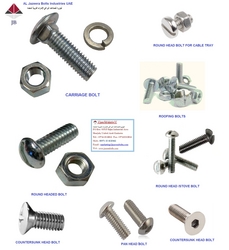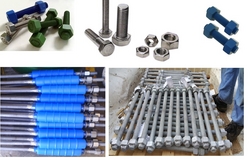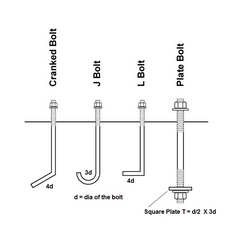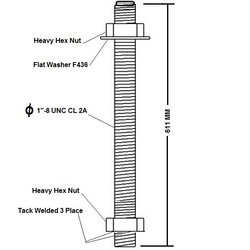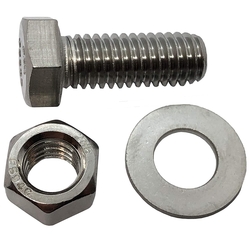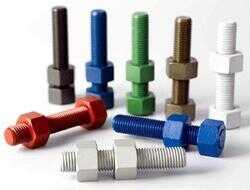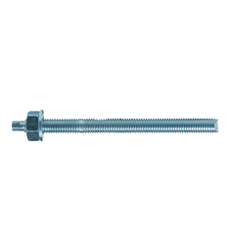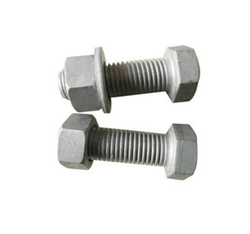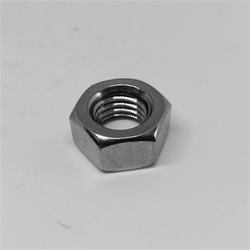high-strength boltsDefinition
Bolts made from high-strength carbon steel or from alloy steel that has been quenched and tempered.
Are there any other "high strength" bolts other an A325, A449 or A490? Would SAE Grade 5 and 8 qualify?The term “high strength” is a somewhat ambiguous term in fastener. Most people in the industry would interpret the phrase “high strength” to refer to any bolt that has been quenched and tempered (heat treated) to develop its strength. Additionally, the ASTM specification F1554 Grade 55 is commonly referred to as being manufactured from a “high strength, low alloy steel”, even though this material is not heat treated. Any grades on our Strength Requirements by Grade Chart with a “Quenched & Tempered” in the Material & Treatment Column undergo heat treatment and would be considered high strength by most people in the fastener industry. Both SAE J429 Grades 5 and 8 have been quenched and tempered and would be considered “high strength” by most.Bolt Grade Markings and Strength Chart
| Head Marking | Grade and Material | Mechanical Properties |
|---|
| Min. Tensile Strength (psi) |
|---|
| 3 Radial Lines | Grade 5 Medium carbon steel, quenched and tempered | 120,000 |
| 105,000 |
| 6 Radial Lines | Grade 8 Medium carbon alloy steel, quenched and tempered | 150,000 |
ASTM F1554
The ASTM F1554 specification was introduced in 1994 and covers anchor bolts designed to anchor structural supports to concrete foundations. F1554 anchor bolts can take the form of either headed bolts, straight rods, or bent anchor bolts. The three grades 36, 55, and 105 designate the minimum yield strength (ksi) of the anchor bolt. The bolts can be either cut or roll threaded and a weldable grade 55 can be substituted for grade 36 at the supplier’s option. Color coding on the end – 36 blue, 55 yellow, and 105 red – helps facilitate easy identification in the field. Permanent manufacturer and grade marking is allowed under the S2 supplementary requirements.
Applications for F1554 anchor bolts include columns in structural steel framed buildings, traffic signal and street lighting poles, and overhead highway sign structures to name just a few.
F1554 Grades
| F1554 Grade 36 | Low carbon, 36 ksi yield steel anchor bolts |
|---|
| F1554 Grade 55 | High strength, low alloy, 55 ksi yield steel anchor bolts |
|---|
| F1554 Grade 105 | Alloy, heat treated, high strength 105 ksi yield steel anchor bolts |
|---|
Supplementary Testing
Supplementary requirements shall apply only when specified in the purchase order or contract.
S1: Weldable version of the Grade 55 specification. Through chemical composition restrictions and by a carbon equivalency formula, S1 provides assurance of weldability. When S1 is not specified, the Grade 55 material may or may not be weldable.
S2: Permanent manufacturer’s identification on the end of the anchor bolt that projects from the concrete, in lieu of color coding.
S3: Permanent grade identification on the end of the anchor bolt that projects from the concrete, in lieu of color coding.
S4: Charpy Impact requirements at +40⁰F (+5⁰C) for grades 55 and 105. The minimum Charpy V-notch energy requirement is an average of 15ft-lbs for three specimens, with no one specimen falling below 12ft-lbs.
S5: Charpy Impact requirements at -20⁰F (-29⁰C) for grade 105. The minimum Charpy V-notch energy requirement is an average of 15ft-lbs for three specimens, with no one specimen falling below 12ft-lbs.
SAE J429
SAE J429 covers the mechanical and material requirements for inch series fasteners used in automotive and related industries in sizes to 1-1/2” inclusive.
International standards
- SA-193/SA-193M: "Specification for alloy-steel and stainless steel bolting materials for high-temperature service"
- SA-194/SA-194M: "Specification for carbon and alloy steel nuts for bolts for high-temperature service"
- SA-320/SA-320M: "Specification for alloy steel bolting materials for low-temperature service"
- EN 1515: "Flanges and their joints - Bolting"
- EN 1515-1: "Flanges and their joints - Bolting - Part 1: Selection of bolting"
- EN 1515-2: "Flanges and their joints — Bolting — Part 2: Classification of bolt materials for steel flanges, PN designated"
- EN 1515-2: "Flanges and their joints — Bolting — Part 3: Classification of bolt materials for steel flanges, class designated"
- ISO 4017: "Hexagon head screws - Product grades A and B"
- ISO 4032: "Hexagon nuts, style 1 - Product grades A and B"
- ISO 4033: "Hexagon nuts, style 2 - Product grades A and B"




